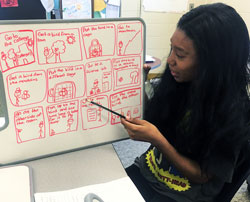Step into Godwin Heights High School biology teacher Cory Klocko’s classroom on any given day, and you’re bound to see few eyes on the teacher. Rather, you’ll see students discussing, hypothesizing and testing their theories to answer questions such as “Why is Addie sick?”
Addie is a character in one of three narratives provided by the Next Generation Science Standards storyline curriculum embraced this year by Klocko and his colleague, biology teacher Derek Stoneman.
Memorizing facts is one thing, but understanding concepts is quite another. Thanks to the three storylines, which cover an entire year of biology curriculum, students are ditching the flashcards and homework and finding that biology is pretty cool when it revolves around telling stories.
As one storyline goes, Addie gets sicker over time and antibiotics aren’t helping. Students have to figure out why, and the solution requires learning about bacterial evolution, growing bacteria on an agar plate and understanding antibiotic resistance, among other things.

Less Memorization, More Assimilation
The new curriculum is unlike anything Madison Hall, a 10th-grader in Klocko’s Biology class, has ever seen.
“The teachers let the students find the answers as a class without telling them the answer directly, and help steer the students in the right direction to understand the material,” Madison explained.
While there’s not much to memorize and homework is rare, “every day is hard,” Klocko said. Attendance is crucial, because the learning takes place inside the discussion.
“The rigor of it is unlike anything I’ve seen or taught with science in the past,” Stoneman said.
Klocko said students were a little confused at first by the shift in thinking: “You’re not going to tell us the answers?” they’d say. But they caught on quickly, he said, and are learning the value in struggling.
They also understand and remember the material after the unit is over because each storyline “lets the students think more about what they are learning and helps the students to understand the answers… instead of just memorizing the answers,” Madison said.
Case in point: after the bell rang following the very first class Stoneman taught using storylines, he said, students were still discussing Addie.
Wendi Vogel, Kent ISD science consultant, said Godwin Heights and Union High School are two Kent County schools using the biology curriculum this year. Michigan adopted NGSS for the state in 2015, and the life science storylines are beginning to take hold here. Vogel said there were two curriculum writers and reviewers in Michigan already, and she tapped them to launch the biology program in Kent County,.
Klocko and Stoneman attended a training on this curriculum last year and and decided last summer that they would follow it for the 2018-1019 school year. The NGSS storylines are a fairly radical departure from the way they used to teach — standing in front of the class, delivering lesson plans.
“It’s really refreshing. Instead of me thinking, ‘What am I going to teach these kids?’ it’s ‘what are these kids going to find out on their own?’” Klocko said. “It’s the best resource there is out there to teach science, in my opinion.”
Seeing students understand and embrace the curriculum has been rewarding for the teachers. The success of it, Klocko said, is partly due to having a collaborator in Stoneman. They meet each morning to discuss their successes and failures with the curriculum. There are no textbooks; all the material is online and readings are embedded into the problems.
Storylines and Bloodlines
“Biology this year is much more fun and enjoyable than the previous years of science,” said Skyler Lambright, a freshman in Klocko’s class.
Skyler particularly enjoyed a recent unit, which used a storyline about Duchenne muscular dystrophy to teach about genetics and inherited conditions. Students learned about the x-linked recessive disorder, and asked, “Why does this mostly affect boys?”
Students can explain the “why” fluently by the time the unit is finished, Stoneman said.
“The kids are figuring it out as they go. It’s not ‘All right, today, I’m going to tell you what natural selection is.’ It’s putting the pieces together through reading, writing and discussion and figuring out what’s happening and why. “They’re going to put together a coherent thought instead of regurgitating what I told them.”
Need evidence that students are engaged?
Klocko said he received an email from a student who had been thinking about a problem they were working on in class — at 8:30 p.m. on a Friday.
CONNECT
SNN article: Figuring out problems, not just learning about them









